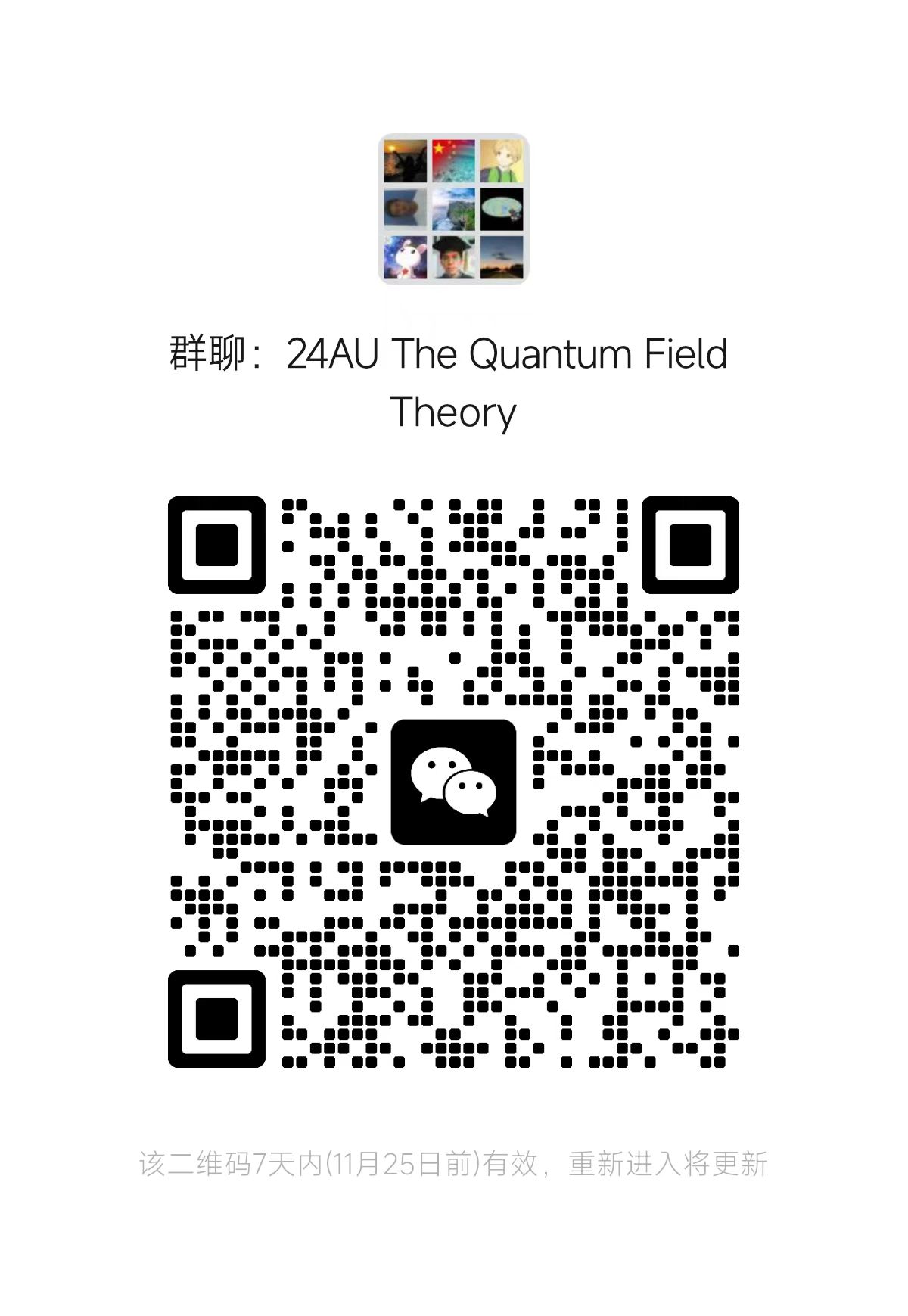The Quantum Field Theory I
This is a course on Introduction to quantum field theory, normally taught as a first semester of quantum field theory for physics graduate students.

日期
2024年10月15日 至 12月09日
位置
| Weekday | Time | Venue | Online | ID | Password |
|---|---|---|---|---|---|
| 周四 | 15:20 - 16:55 | A3-2-303 | Zoom 16 | 468 248 1222 | BIMSA |
| 周一 | 13:30 - 15:05 | A3-2-303 | Zoom 16 | 468 248 1222 | BIMSA |
修课要求
Basic knowledge of quantum mechanics and classical electrodynamics.
课程大纲
The major themes of the course are the basic fundamental concepts and building blocks of modern quantum field theory.
A. Field Theory
1.The Introduction.
The birth of the Quantum Field Theory.
2.The microscopic theory of radiation.
Blackbody radiation. Einstein coefficients. Quantum Field Theory.
3.Lorenz Invariance and second quantization.
Lorenz invariance. Classical plane waves as oscillators. Second quantization.
4.Classical Field theory.
Hamiltonians and Lagrangians. The Euler-Lagrange Equations. Noether’s theorem. Coulomb’s law. Green’s functions.
5.Old-fashioned perturbation theory.
Lippman-Schwinger equation. Early infinities.
6.The Cross sections.
Non-relativistic limit. Electron positron Scattering.
7.The S-matrix and time-ordered products.
The LSZ reduction formula. The Feynman propagator.
8. Feynman rules.
Lagrangian derivation. Hamiltonian derivation. Momentum-Space. F1eynman rules. Examples. Normal ordering and Wick’s theorem.
B. Quantum Electrodynamics
9.Spin 1 and gauge invarian6ce.
Unitary representations of the Poincare group. Embedding particles into fields. Covariant derivatives. Quantization and the Ward identity. The photon propagator. Is gauge invariance real? Higher spin fields.
10. Scalar Quantum electrodynamics.
Quantizing complex scalar fields. Feynman rules for scalar QED. Scattering in scalar QED. Ward identity and gauge invariance. Lorenz invariance and charge conservation.
11. Spinors.
Representation of the Lorenz group. Spinor representation. Dirac matrices. Coupling to the photon. What does spin ½ mean? Majorana and Weyl fermions.
A. Field Theory
1.The Introduction.
The birth of the Quantum Field Theory.
2.The microscopic theory of radiation.
Blackbody radiation. Einstein coefficients. Quantum Field Theory.
3.Lorenz Invariance and second quantization.
Lorenz invariance. Classical plane waves as oscillators. Second quantization.
4.Classical Field theory.
Hamiltonians and Lagrangians. The Euler-Lagrange Equations. Noether’s theorem. Coulomb’s law. Green’s functions.
5.Old-fashioned perturbation theory.
Lippman-Schwinger equation. Early infinities.
6.The Cross sections.
Non-relativistic limit. Electron positron Scattering.
7.The S-matrix and time-ordered products.
The LSZ reduction formula. The Feynman propagator.
8. Feynman rules.
Lagrangian derivation. Hamiltonian derivation. Momentum-Space. F1eynman rules. Examples. Normal ordering and Wick’s theorem.
B. Quantum Electrodynamics
9.Spin 1 and gauge invarian6ce.
Unitary representations of the Poincare group. Embedding particles into fields. Covariant derivatives. Quantization and the Ward identity. The photon propagator. Is gauge invariance real? Higher spin fields.
10. Scalar Quantum electrodynamics.
Quantizing complex scalar fields. Feynman rules for scalar QED. Scattering in scalar QED. Ward identity and gauge invariance. Lorenz invariance and charge conservation.
11. Spinors.
Representation of the Lorenz group. Spinor representation. Dirac matrices. Coupling to the photon. What does spin ½ mean? Majorana and Weyl fermions.
听众
Undergraduate
, Advanced Undergraduate
, Graduate
, 博士后
, Researcher
视频公开
公开
笔记公开
公开
语言
英文
讲师介绍
Hrachya Babujian (Babujyan) received his PhD from L. D. Landau Institute of Theoretical Physics in Moscow, where he was PhD student of A.A. Belavin. The Habilitation he get in Yerevan Physics Institute (Alikhanyan National Lab) where he currently holds the title Leading Scientific Researcher. In the 1990’s he was working in Bonn University and Berlin FU where he enjoy the Mathematical Physics group of R. Schrader. He also work in Sao Carlos University (Brazil) in Brookhaven National Lab, Simons Center and Chicago University. H. Babujian’s research interests are in Integrability in 2d statistical models and 1+1 dimensional quantum field theories, 1d spin chains, conformal blocks, form factors and thermodynamics of integrable models. Now his interest is the applications of the exact form factors in 1+3 dimensional lepton-hadron scattering in small Bjorkan x case.





